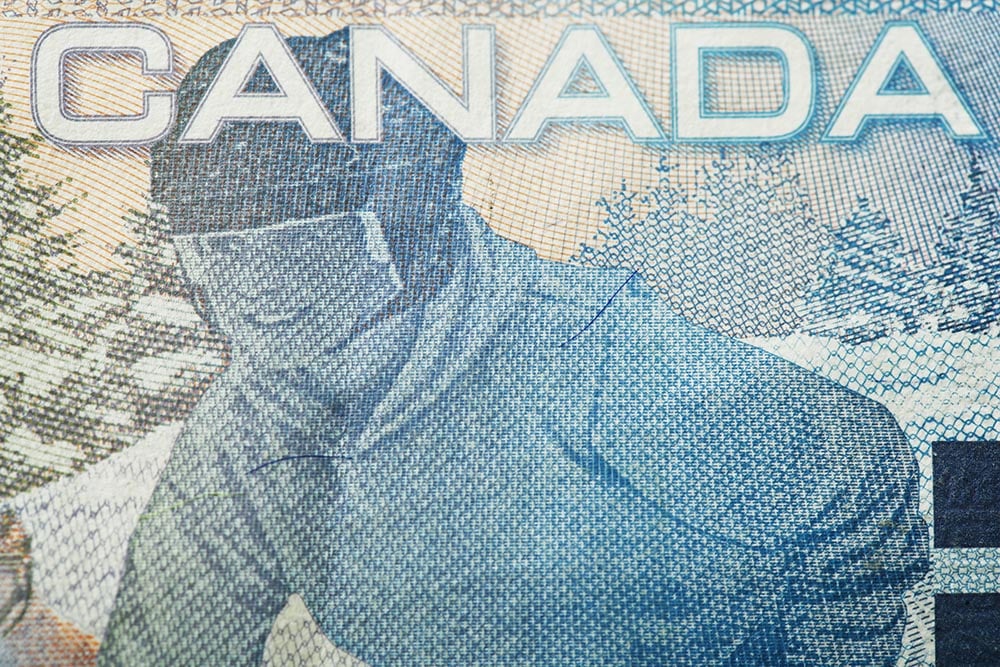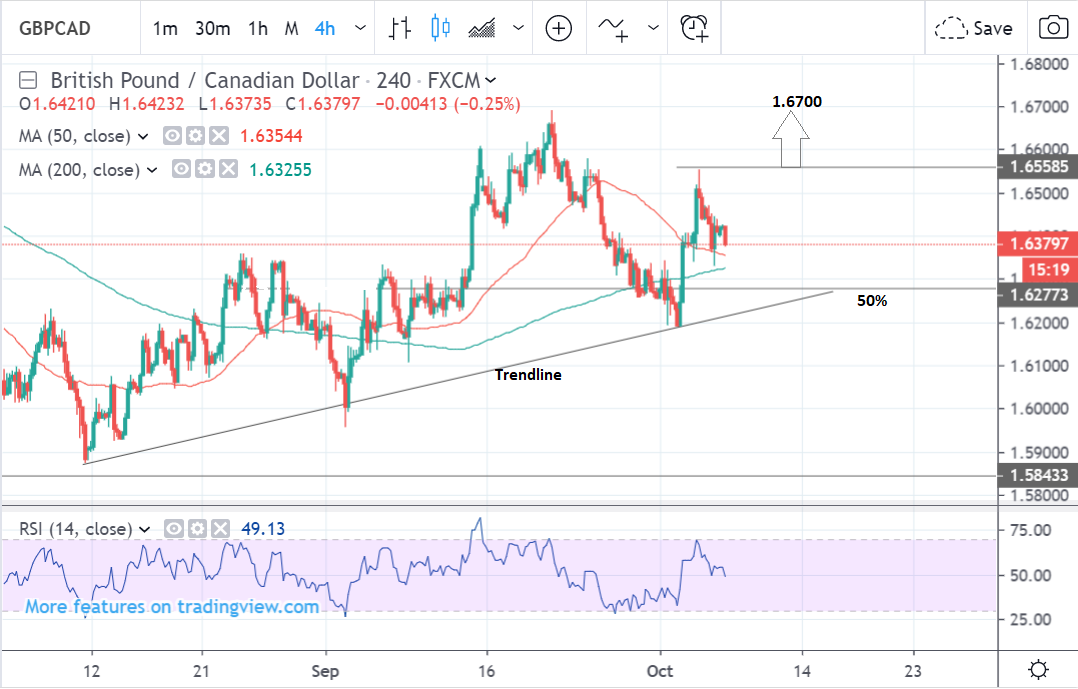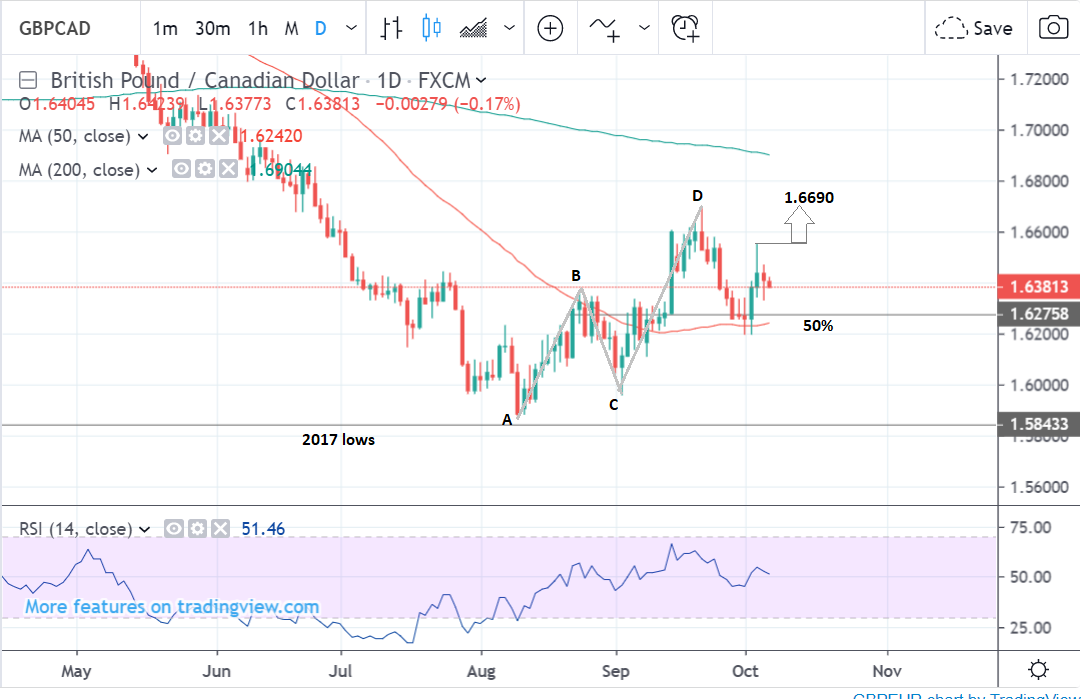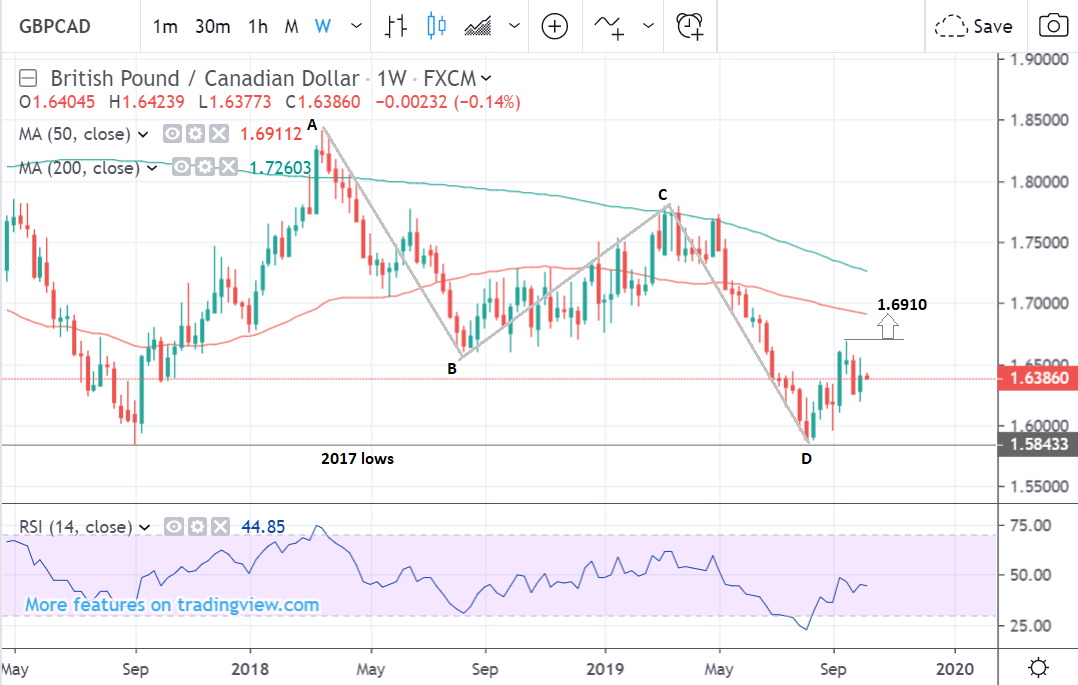The Pound-to-Canadian-Dollar Rate in the Week Ahead: Trading with an Upside Bias

Image © Adobe Stock
- GBP/CAD bounces off support on charts.
- Potential for more upside is on the horizon
- CAD eyes global risk trends, GBP eyes Brexit.
The Pound-to-Canadian-Dollar rate is trading at around 1.6404 at the start of the new week after closing the previous one almost a full percentage point higher, but the exchange rate is biased toward a continuation higher in the days ahead.
The 4 hour chart - used to determine the short-term outlook, which includes the coming week or next 5 days - shows how the pair recently surged higher after bouncing off support, and the strength of the recovery is a sign it will probably continue.
Although the pair has pulled back from its peak in the 1.65s if it can recover and break back above the 1.6555 highs that will greenlight a continuation higher to a target at 1.6700.

Above: GBP/CAD rate shown at 4-hour intervals.
The daily chart shows how the pair completed an ABCD pattern, then fell down to a support zone in the 1.62s before recovering higher over the last few days in what looks like a resumption of the short-term uptrend.
Given its fairly strong start so far, the uptrend is biased to continue, and a break above the 1.6554 highs would probably lead to a continuation up to a target at 1.6690. The daily chart is used to give us an indication of the outlook for the medium-term defined as the next week to a month ahead.

Above: GBP/CAD rate shown at daily intervals.
The weekly chart shows the pair bouncing up off the 2017 lows after completing a large bearish ABCD pattern. Given the bullish forecasts on the lower timeframe charts, we see the possibility of more upside on the horizon subject to a confirmatory break.
A break above the 1.6692 highs would provide confirmation of a continuation higher to a target at 1.6910. The weekly chart is used to give us an idea of the longer-term outlook, which includes the next few months.
 AA
AA
Above: GBP/CAD rate shown at weekly intervals.
The Canadian Dollar: What to Watch
The main drivers of the Canadian Dollar in the coming week include employment data on Friday, which will provide a snapshot of the health of the economy, the price of oil, Canada’s largest export, and global risk trends.
Previous market optimism over the start of a new round of trade talks between the U.S. and China scheduled for Thursday may have been premature after reports the Chinese want to substantially narrow the scope of issues under discussion.
The Chinese delegation will not be open to discussing the following issues: state subsidies, intellectual property theft, and technology transfer. This excludes some key areas Trump will want to include in any negotiation of a comprehensive trade deal. It suggests less chance something positive will emerge.
Trump said on Friday that, “we’ve had good moments with China. We’ve had bad moments with China. Right now, we’re in a very important stage in terms of possibly making a deal. But what we’re doing is we’re negotiating a very tough deal. If the deal is not going to be 100% for us, then we’re not going to make it.”
If it looks like trade talks are leading nowhere then the Canadian Dollar could be at risk of falling on the news.
The U.S - China trade war has been a major factor weighing on global manufacturing growth which has contaminated Canadian manufacturing so a prolongation of the war will continue to weigh on the outlook for the country’s domestic economy too.
The success of trade talks may also impact on the price of oil and via that the Canadain Dollar since oil is the country's chief export. When oil prices rise aggregate demand for the Canadain Dollars to buy the oil rises, supporting the currency and vice versa when it falls.
After spiking sharply higher to above $70 per barrel following the drone attacks in Saudi the price of Brent crude oil has tumbled quite steeply to $58 at the time of writing due partly to a fall in global demand, which is now as low as it was during the financial crisis.
The fall in global demand is due to the slowdown in world manufacturing triggered by trade tensions. An increase in tensions will probably push oil down even lower, with a negative knock-on effect on the Canadian Dollar.
“Looking at the global economy weakening…China, the driver of global oil demand, experiencing the lowest economic growth since 30 years. The advanced economies are slowing down. We may well revise down our demand numbers in the next days or months to come,” says Fatih Birol the executive director of the IEA.
The OPEC monthly report out on Thursday and the OPEC meeting on Friday morning are two other key events for oil in the week ahead, since OPEC may announce further supply cuts to support oil prices.
Another key driver of the currency in the coming week could be Canadian employment data out on Friday. The data is forecast to show employment rise by 7.5k in the month of September and for the unemployment rate to remain unchanged at 5.7%.
Last month showed a very strong 81k rise, setting the bar high for another strong month. A higher than expected reading should be taken as bullish for the CAD, while a lower than expected reading should be taken as bearish for the CAD.
AA
The Pound: What to Watch
Brexit news will continue to dominate the Pound in the week ahead, whilst on the hard data front industrial and manufacturing production are the main releases along with the second estimate of Q2 GDP.
From a Brexit standpoint, the main focus will be on whether the UK and EU can strike a deal or at least a semblance of a deal - if they can the Pound could rise strongly. Dominic Cummings, a leading force behind the UK's Brexit strategy, has reportedly told aides that if the EU do not strike a compromise and agree to a new plan this week then the UK will be leaving without a deal.
The stakes are certainly high, particularly as there is very little insight into how Prime Minister Boris Johnson intends to exit the EU without a deal on October 31.
According to government papers submitted to a Scottish court on Friday, Johnson will send a letter to the European Union asking for a Brexit delay if no divorce deal has been agreed by October 19. This means the Government intends to abide by the Benn Act which forces the Prime Minister to seek a Brexit extension if a deal has not been passed by parliament on October 19.
However, the British Pound actually went lower on the day as Government sources maintained that while they intend to follow the law, they will still not seek a delay. Steve Baker, the Conservative MP who heads up the party's Eurosceptic European Research Group responded to the government's court papers saying: "a source confirms all this means is that Government will obey the law. It does not mean we will extend. It does not mean we will stay in the EU beyond Oct 31. We will leave."
The UK recently submitted an alternative proposal to solve the problem of the Irish 'backstop' but the initial reaction of leading EU Brexit negotiators and stakeholders was not very positive and suggests the two sides were a long way from meeting in the middle.
Leo Varadkar, the prime minister of Ireland, said the UK’s present proposals “do not form the basis for deeper negotiations.”
The EU's chief Brexit negotiator Michel Barnier said, “there’s improvement...we are not there yet,” but privately was concerned about the proposal’s custom’s checks on the island of Ireland, a red-line for the EU.
Guy Verhofstadt, who heads up the EU Parliament's Brexit oversight committee commented that the proposals were “not positive in that we don’t think really there are the safeguards that Ireland needs.”
The proposal was however well-received by the government’s own party, however, including leading Brexiteers on the one hand and rebel Tory independents on the other. We noted that there is a decent chance the Government could win a majority were they to present a deal based on their latest plans, and this is an all-out positive development for Sterling.
A deal still looks to be some way off however as the further the government moves to meet the demands of the EU, who basically want a customs union in Ireland, the more it will alienate the ERG and DUP, without whose support it has no chance of getting the deal approved by Parliament.
This may overall lead to further pressure on the Pound in the week ahead.
Turning to the economic data, investors will be closely watching industrial and manufacturing data, which are both expected to show a -0.1% result in August from 0.1% and 0.3% respectively in July, when released on Thursday and 9.30 BST.
A combination of Brexit uncertainty and the global manufacturing slowdown have started to show up in British economic data and the recent Services PMI report said there was a heightened chance of a technical recession happening in the UK.
If the results show a deeper-than-expected contraction in the data the Pound will probably weaken.
Q2 GDP is expected to remain unrevised for its second estimate, with the quarterly reading to continue to show 0.0% growth, yearly 1.3% and monthly 0.3%.
If results are revised down the Pound will follow suit.
Time to move your money? Get 3-5% more currency than your bank would offer by using the services of foreign exchange specialists at RationalFX. A specialist broker can deliver you an exchange rate closer to the real market rate, thereby saving you substantial quantities of currency. Find out more here.
* Advertisement





